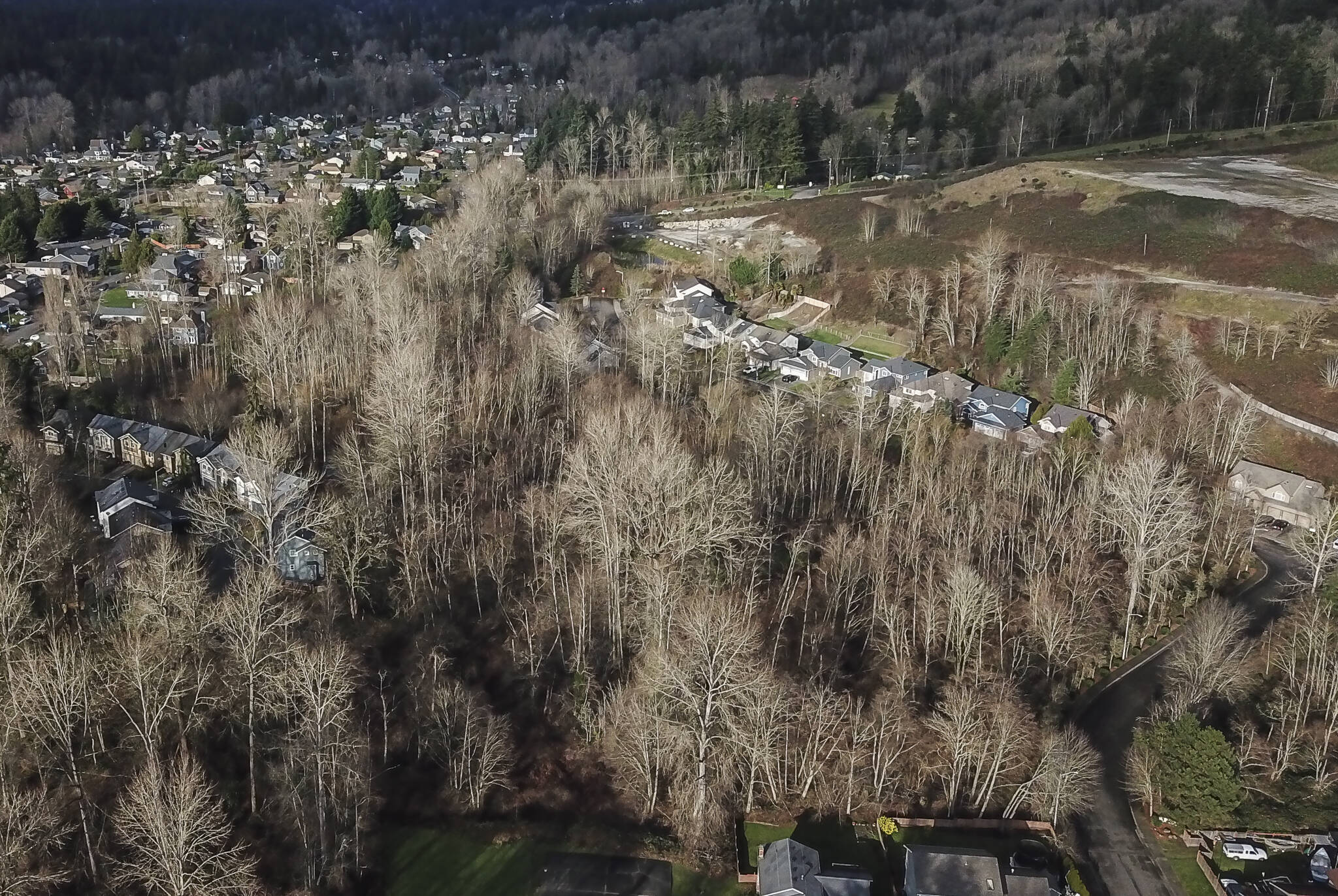EVERETT — Snohomish County Council will likely decide on Wednesday if buffers to wetlands, streams and other critical habitats will be cut in half for development opportunities.
For the past year, the Washington State Department of Ecology has worked with Snohomish County’s Planning and Development Services to help update the Critical Area Regulations ordinance, which cover wetlands, fish and wildlife conservation areas, geologically hazardous areas, aquifer recharge areas and some flood hazard areas.
But council members Jared Mead and Nate Nehring have introduced amendments to the ordinance, decreasing environmental protections to create flexibility for possible development.
Both council members failed to respond to multiple requests for comment before deadline.
The amendments modify criteria for reducing buffer widths around habitat without requiring scientific study or creating a mitigation plan to minimize the effects of the changes.
The introduced language in the amendments allows a 15% reduction in buffers when a fence is constructed around a habitat. Mead and Nehring’s language also reduce the standard buffer requirement for streams, lakes, marine waters and wetlands over 4,000 square feet by 50% or 25 feet, meaning development would be allowed to encroach closer to these environments.
Mead and Nehring introduced changes to the ordinance, reasoning the amendments will allow more flexibility for new development, help address housing affordability challenges and reduce pressure to expand urban growth areas in the future.
The amendments also state, in some situations, wetlands under 4,000 square feet could be completely filled.
State agencies, environmentalist groups and community advocates have raised their concerns about the amendments, and some have urged the county council to postpone its decision on the matter.
Tom Murdoch, executive director of Adopt a Stream Foundation, a Pacific Northwest riparian education and restoration nonprofit, sent a letter to followers, detailing potential consequences if the proposed amendments passed.
“Anyone concerned about the mother orca carrying her dead baby around should be concerned about Snohomish County decreasing wetlands protections,” he said on Jan. 6.
A public hearing is set for 10:30 a.m. Wednesday in the council chambers. Council member Megan Dunn said it’s unlikely that a decision about whether or not to adopt the amendments will be pushed to a later date because the county was supposed to adopt updates in December.
“I’m not sure if I’ll be supporting them,” she said. “We have to think about our needs, our housing needs, but it means nothing if we don’t have clean water.”
The state’s Department of Ecology routinely assists local governments to update Critical Area Regulations, making sure county ordinances meet the goals of the Growth Management Act.
The Growth Management Act is the state law that requires fast-growing cities and counties to develop a comprehensive plan to manage their population growth to reduce urban sprawl and prevent environmental degradation.
Critical Area Regulations or ordinances fit into those comprehensive plans, creating boundaries and criteria for development around ecologically important habitats, such as wetlands.
The county is obligated to update its regulations every 10 years while it creates a new comprehensive plan.
“We have [a] model ordinance they could just cut and paste and plug right into their ordinance, and we’d be happy with it,” said Doug Gresham, Snohomish wetlands specialist for Ecology. “And we pretty much got them to that point. It wasn’t perfect, but it was close.”
As county planning and development staff worked with Ecology on ordinance updates, they gathered additional input from local tribes and interest groups.
After planning staff compile their findings and present them to the County Planning Commission, the commission puts together an ordinance to send to the council. After passing along the report to the commission, the fate of the planning staff’s work is out of its control.
“We’re essentially hands-off unless they [County Council] ask us to review something or comment on something,” said Terri Strandberg, a long-range principal planner for the county.
The Department of Ecology’s provided language to county planning staff supports a “moderate-risk approach” to wetland protections, compromising the best outcome of environmental health for flexible development opportunities.
But the proposed amendments from Mead and Nehring push the ecological risks further, Gresham said.
“When the county comes up with a reduction of 50% … they’re taking a high-risk approach to wetland protection,” Gresham said. “There’s going to be indirect impacts to the wetland because there’s not enough vegetation to slow down stormwater runoff, to remove pollutants, to provide wildlife habitat.”
The Department of Ecology uses buffer averages instead of strict measurements in its guidance given to local governments to accommodate development needs.
“They want some flexibility and be able to provide housing because there’s so much demand in the population, and I get that,” Gresham said. “That’s why we have offered the averaging as a way around that. If a driveway of the corner of a house does encroach into a buffer, maybe 25%, then you just widen it somewhere else to make up for that square footage.”
The guidance document used by Ecology was updated in 2022 and draws from a variety of studies and scientific documents, including the state department’s “Best Available Science” report from 2016.
The scientific documents supporting Mead’s and Nehring’s amendments come from a decade before the state’s report.
“Those [numbers] are based on the original code that was adopted in 2006,” Strandberg said. “We had a precursor regulation, and some of those numbers came out of that, so 1990-ish.”
In 2006, Snohomish County created a Best Available Science report, which is a consolidation of scientific studies the government can use to base policy on. The Growth Management Act requires counties to include the best available science when developing critical area regulations.
The report hasn’t been remade in 19 years. However, the county added an annotated bibliography in 2024.
“Including BAS [Best Available Science] does not mean solely relying on it,” a staff report about the amendments filed by county council legislative analyst Ryan Countryman said. “As with any complex intersection of science and policy, there is scope for legislative bodies to debate and determine appropriate regulation.”
Another amendment added by Mead and Nehring was the ability for wetlands under 4,000 square feet to be filled if certain criteria were met.
A mere 4,000-square-foot wetland is a significant water storage area because planners must consider a third dimension — depth.
At just one foot deep, a 4,000-square-foot wetland would hold 4,000 cubic feet of water. To convert cubic feet to gallons, you multiply 4,000 by 7.481 gallons, which equates to 29,924 gallons of water forced to go elsewhere if a wetland is filled for development.
So, while important habitats for wildlife, wetlands and robust buffers also provide critical flood protection for surrounding communities, Gresham said.
“When there’s runoff from a development, the stormwater has pollutants and nutrients, and the vegetation does a really good job of slowing down the velocity of that runoff and making it soak into the ground,” he said.
If buffers are reduced or whole wetlands are filled, an area loses a vital sponge.
Because of climate change, more precipitation is falling as rain instead of snow, meaning water immediately fills rivers and streams instead of being stored in snowpack that slowly melts as spring rolls around.
Without wetlands to soak up extra influxes of water, it’s easier for flooding to happen.
“If you want to put it into this economic value to society, the [wetlands] protects a bridge from getting wiped out or whole community being flooded,” Gresham said. “It protects salmon habitat from being washed out by bit floods.”
Community members have expressed their concerns about the proposals, writing to the county council to table the decision set for Jan. 15.
“This last-minute change to allow major revisions in the Critical Areas Ordinance to allow wetlands to be filled and reduction in minimum wetland buffer widths is being ram-rodded through, in the dark, and without consideration for public participation,” Lynwood civil engineer Bill Lider wrote Jan 8. in an email chain to County Council. “The final ordinance language is being hidden as is the staff report in an effort to thwart public participation.”
Linda Gray, another county resident, followed up in the chain, saying that the lack of information violated state codes on public participation.
One state law she referenced states “Each county and city planning under the act must establish procedures for early and continuous public participation in the development and amendment of comprehensive plans and development regulations.”
Countryman, a legislative analyst for the council, responded in the email chain.
“The hearing has already been set to begin on January 15. This cannot be changed,” he wrote. “As you have observed regarding the proposed amendment, details are not yet publicly available. At the hearing on January 15, the Council has the option to continue the hearing to a later date, which will be up to their discretion at that time.”
Eliza Aronson: 425-339-3434; eliza.aronson@heraldnet.com; X: @ElizaAronson.
Eliza’s stories are supported by the Herald’s Environmental and Climate Reporting Fund.
Talk to us
> Give us your news tips.
> Send us a letter to the editor.
> More Herald contact information.


























